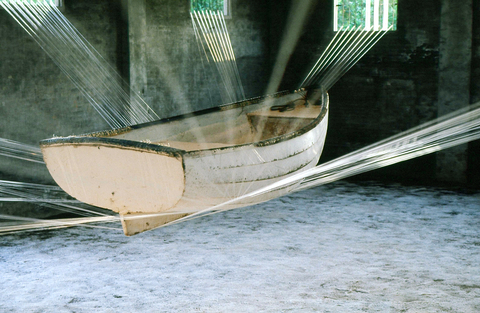Dan Cameron (New York's New Museum senior curator) and Wang Jun-jieh (
International exhibitions such as the Taipei Biennial (which began in 1998 and is still going strong) are important for Taiwan's beleaguered international status, but not many artists have the honor of having their work shown at such high profile exhibitions.
The artist villages that have been springing up in recent years create a flourishing climate for cultural diplomacy and exchanges and are a good way for artists to get a foot in the industry door and build connections. They are also a great way of strengthening international and local community ties through third-track diplomacy.

PHOTO COURTESY OF BAMBOO CURTAIN STUDIO
For these art villages to survive they need to develop a symbiotic relationship with local residents, so they host workshops for home-makers, crafts classes for children, teaching skills to teens in addition to holding open studios, exhibitions and performances with the visiting artists who come from all corners of the globe. It is a surprise this hasn't happened sooner as the partnering of government cultural bodies with grassroots organizations is proving to be a happy marriage indeed.
Keeping it all together is the job of the Taiwan Artist Village Alliance (TAVA) which manages the resi-dency programs throughout Taiwan, and focuses on enriching the local cultural heritage while introducing new ideas via this international arts exchange. TAVA reaches out to the student population, seeking their help with volunteer programs and producing publications, workshops, lectures and exhibitions. Also professional consultation and guidance is available to help make all these programs work at an effective level.
Head of the 11-year-old Bamboo Curtain Studio, Margaret Tan believes art residencies can help change the world and says, "We look forward to accommo-dating any creative processes as we truly believe that art should be used as an instrument to influence social change."
For your information:
What: Art Residencies in Taiwan
Where: Taiwan Artist Village Alliance, 128, Tainan County (麻豆郵政信箱128號).
Tel: (06) 571-8875.
Web: www.tava.org.tw
● Taipei Artist Village (7 Beiping Rd, Taipei; 台北市北平東路7號), Taichung's Stock 20 (6-6, Lane 17, Fuhsing Rd Sec 4; 台中市復興路四段17巷6之6號,) which transformed an unused part of a railway warehouse and opened in June 2000, Kaoshiung's Kio-a-thau Art Village, an old sugar factory (1, Alley 1, Hsingtang Rd; 高雄縣橋頭鄉興糖路1巷1號) are all fine examples of linking the community with the arts.
● Hualien's Pine Garden (549 Chungshan Road; 花蓮市中山路549號) transformed a Japanese military center into a peaceful site for dance, painting and environmental awareness in the midst of its fresh pine tree setting.
● To get away from it all, consider Hwataoyao's beautiful setting in Miaoli (31 Nanshih Li, Yuanli Township; 苗栗縣苑裡鎮南勢里2鄰31號), which opened its kiln in 1991 as a venue for the appreciation of nature and to revitalize Taiwan's traditional tea ceramics.
● Going offshore, there is also the Tungpan Artist Village (Magung City, Penghu; 澎湖縣馬公市桶盤里47號), on the windswept Penghu Archipelago.
Each of these locations has its own individual charm and is a haven for aspiring artists.

May 18 to May 24 Pastor Yang Hsu’s (楊煦) congregation was shocked upon seeing the land he chose to build his orphanage. It was surrounded by mountains on three sides, and the only way to access it was to cross a river by foot. The soil was poor due to runoff, and large rocks strewn across the plot prevented much from growing. In addition, there was no running water or electricity. But it was all Yang could afford. He and his Indigenous Atayal wife Lin Feng-ying (林鳳英) had already been caring for 24 orphans in their home, and they were in

President William Lai (賴清德) yesterday delivered an address marking the first anniversary of his presidency. In the speech, Lai affirmed Taiwan’s global role in technology, trade and security. He announced economic and national security initiatives, and emphasized democratic values and cross-party cooperation. The following is the full text of his speech: Yesterday, outside of Beida Elementary School in New Taipei City’s Sanxia District (三峽), there was a major traffic accident that, sadly, claimed several lives and resulted in multiple injuries. The Executive Yuan immediately formed a task force, and last night I personally visited the victims in hospital. Central government agencies and the

Australia’s ABC last week published a piece on the recall campaign. The article emphasized the divisions in Taiwanese society and blamed the recall for worsening them. It quotes a supporter of the Taiwan People’s Party (TPP) as saying “I’m 43 years old, born and raised here, and I’ve never seen the country this divided in my entire life.” Apparently, as an adult, she slept through the post-election violence in 2000 and 2004 by the Chinese Nationalist Party (KMT), the veiled coup threats by the military when Chen Shui-bian (陳水扁) became president, the 2006 Red Shirt protests against him ginned up by

As with most of northern Thailand’s Chinese Nationalist Party (KMT) settlements, the village of Arunothai was only given a Thai name once the Thai government began in the 1970s to assert control over the border region and initiate a decades-long process of political integration. The village’s original name, bestowed by its Yunnanese founders when they first settled the valley in the late 1960s, was a Chinese name, Dagudi (大谷地), which literally translates as “a place for threshing rice.” At that time, these village founders did not know how permanent their settlement would be. Most of Arunothai’s first generation were soldiers